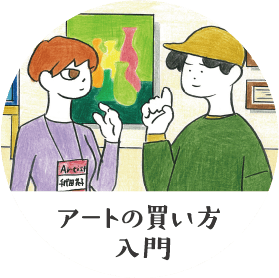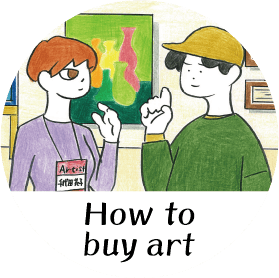「みえるものとみえざるものをつなぐこと」をテーマに、主に絵画表現を中心とした美術作品の制作、発表を行う。
古来より人びとのなかに無意識のうちに根付いている、「目にみえないもの」を信じ、五感で感じ取ろうとする精神性に関心を持ったことから、その存在や信仰とは何かを問うようになる。
現在は、時間・存在の概念において異なる事物の断片を組み合わせるように描く手法を用いて、「みえるもの」と「みえないもの」をつなぎ、あるいは両者の境界を示すことを試みている。
【プロセス】
私の絵画は断片を組み合わせるようにして構成されており、制作プロセスとしては、先ず視覚だけでは捉えきれないものを、「依り代」と称する小さな立体物を制作することで五感を通じて把握し、そこからイメージを拡張させていきます。
「依り代」には以下のルールを設けており、
・作品ごとに最低1つは描かれている、作品の核となるものである
・イメージを拡張させるための道具であり、″イメージを降ろす″ ための祈りの道具でもある
・絵画を想像だけで完結させないための、視て触れることが出来るドローイングという位置付けだが、そっくりそのまま描くわけではなく、あくまで作品の起点である
・自らの痕跡を作品に繋ぎ止めるため、日常において自身が手に入る卑近な事物を組み合わせて制作する
以上を満たすものとしています。
次に、既存や架空のモチーフを交えて、合成と解体を繰り返しながら絵画として構築します。
「依り代」から得られるイメージ以外には、過去に人が作り出したもの(哲学・宗教・神話・文字・数字など、文明の根源)を中心に描いており、近作では、他者が生み出した、役目を終えて使われなくなったような道具を作中に描き込んでいます。
道具には作り手の願いが込められており、それは祈りでもあります。「依り代」が自らの祈りを昇華させるための道具だとするならば、他者が作り出した道具を画中に取り入れることは、今はもう果たすことが出来ない他者の祈りを別の形で昇華(付喪神のような存在として神格化)させるような行為であると考えています。
私たちは、手の届く範囲でしか物質を感じることができず、ものごとを断片的にしか認知出来ません。
私の絵画もまた断片の集積であり、作中には時間・存在の概念において異なる事物が同一画面上に混在しています。
現在/過去・実在/架空、それぞれの断片を多角的に組み合わせて絵画として構築することで、「みえるもの」と「みえざるもの」をつなぎ、あるいは両者の境界を示すことを試みています。
【呼び継ぎ シリーズについて】
近年、別々の絵画を繋ぎ合わせたような「呼び継ぎ」シリーズの作品を展開 しています。
「呼び継ぎ」とは、欠けた陶器や漆器を金で繕う「金継ぎ」技法のひとつであり、大きく 欠けてしまった器の欠損部分を他器の破片を利用して埋め、金で繕うことで新たな器 として再生するというものです。
いわゆる「金継ぎ」はあくまで修繕であり、言うなればまだ生きている器を「治癒」 させるという意味合いが 強いのですが、「呼び継ぎ」はバラバラになり死んだ器を「蘇生」させるための儀式のように感じています。
呼び継がれた器の破片にそれぞれの物語があるように、継ぎ接ぎの絵画が、それぞれ の断片の外側へ続く見えない存在を想起させることができればと考えています。
I create and present works of art, mainly in the form of pictorial expressions.
My interest in the spirituality of believing in "invisible things" that has been unconsciously rooted in people since ancient times, and trying to sense them with the five senses, has led me to question the concept of existence and belief.
Currently, he attempts to connect the "visible" and the "invisible" or to show the boundary between the two by using a technique in which fragments of things that have different concepts of time and existence are drawn in a combined manner.
【Process】
In the process of creating my works, I first grasp through the five senses what cannot be grasped by the sense of sight alone by creating small three-dimensional objects called "Yorishiro," and then expand the image from there.
The following rules apply to "Yorishiro"
・At least one "Yorishiro" is drawn for each work, and it is like the core of the work.
・It is a tool to expand the image, and a tool of prayer to bring down the image.
・The paintings are positioned as drawings that can be seen and touched so that they are not completed only in the imagination, but they are not drawn exactly as they are, but they are positioned as a starting point for the work.
・In order to hold his own traces in the work, he combines everyday objects that are available to him in his daily life.
I consider objects that fulfill the above conditions to be "Yorishiro".
Next, he mixes fragments of all kinds of existing and fictitious images, repeatedly synthesizing and deconstructing them to construct his paintings.
In addition to "Yorishiro," the motifs that compose his paintings are mainly things created by people in the past (philosophy, religion, mythology, letters, numbers, and other roots of civilization), and in his recent works, he depicts tools that were created by others and are no longer in use.
The tools are filled with the wishes of their makers, which are also prayers.
If "Yorishiro" is a tool to sublimate one's own prayer, then incorporating tools created by others in my paintings is an act of sublimating the prayers of others that can no longer be fulfilled in another form (deifying them as a kind of mourning god).
We can only perceive materials within our reach, and we can only perceive things in fragments.
My paintings are also an accumulation of fragments, and in my paintings, different things with different concepts of time and existence are mixed together on the same canvas.
By combining fragments of the present/past, real/fictitious, and each from various angles and constructing them as paintings, I attempt to connect the "visible" and the "invisible," or to show the boundary between the two.
【About the "Yobitsugi" series】
In recent years, he has been developing the "Yobitsugi" series of paintings that look like separate paintings pieced together.
"Yobitsugi" is one of the techniques of "Kintsugi," a process of repairing chipped pottery or lacquer ware with gold, in which the missing part of a vessel is filled with a piece of another vessel and repaired with gold to make a new vessel.
While the so-called "Kintsugi" is a form of repair and has a strong meaning of "healing" a vessel that is still alive, I feel that "Yobitsugi" is a ritual to "revive" a vessel that has been dismembered and died.
Just as each fragment of a vessel has its own story to tell, I hope that the spliced paintings will remind us of the invisible existence that continues outside of each fragment.

Photo by Ayumi Okamoto
鮫島 ゆい
Yui Samejima
1988年 京都生まれ
2010年 京都精華大学芸術学部版画専攻卒業
2022年 ブルーピリオド展 / BLUE ART COLLABORATION 、寺田倉庫、東京
2022年 Fragments of unvoiced voices 、KATSUYA SUSUKI GALLERY、東京
2021年 エマージング・アーティスト展、銀座 蔦屋書店 GINZA ATRIUM、東京
2021年 鮫島ゆい展 もつれるルーパ tangled rūpa、GALLERY VALEUR、愛知
2020年 鮫島ゆい展 境界のミチカケ、2kw gallery、滋賀
1988 Born in Kyoto
2010 Graduated from Kyoto Seika University, B.A. Print making
2022 Blue Period Exhibition / BLUE ART COLLABORATION, Terada Warehouse, Tokyo
2022 Fragments of unvoiced voices , KATSUYA SUSUKI GALLERY, Tokyo
2021 Emerging Artist Exhibition, Ginza Tsutaya Bookstore GINZA ATRIUM, Tokyo
2021 Yui Samejima Exhibition Tangled rūpa, GALLERY VALEUR, Aichi
2020 Yui Samejima Exhibition KYOKAI NO MICHIKAKE, 2kw gallery, Shiga
推薦者
Selector
DMOARTS ディレクター/digmeout プロデューサー/UNKNOWN ASIA エグゼクティブプロデューサー
Director of DMOARTS / Producer of digmeout / Executive producer of UNKNOWN ASIA







